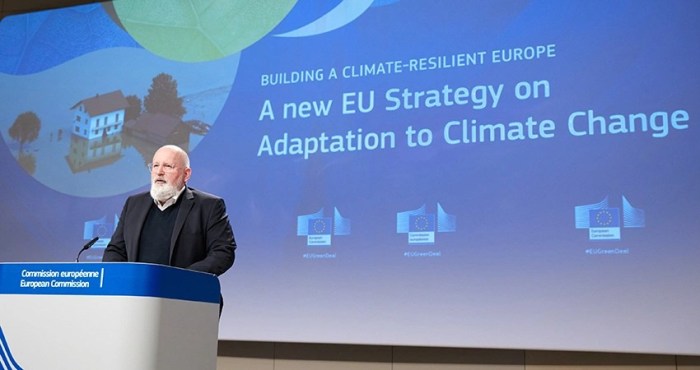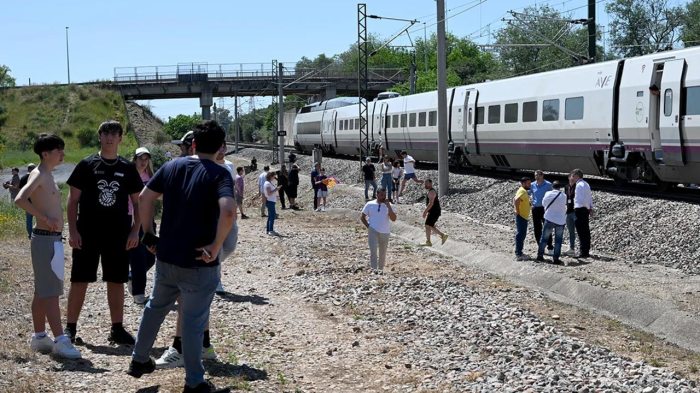
Sustainable switch climate focus Europe boosts water preservation efforts. Europe faces a critical water challenge, one deeply intertwined with climate change. Water scarcity is no longer a distant threat; it’s a pressing reality impacting agriculture, industry, and human health across the continent. This shift in focus highlights the urgent need for innovative solutions and collective action to secure water resources for generations to come.
This post explores the multifaceted issue of water management in Europe, from historical perspectives and current challenges to the role of technology, policy, and community engagement in fostering a sustainable future. We’ll examine the impacts of climate change on water resources, explore European Union policies, and highlight innovative solutions being implemented across various sectors. The discussion will also touch on the importance of public awareness and international cooperation to ensure long-term water security.
Introduction to Sustainable Water Management in Europe

Europe, a continent renowned for its diverse landscapes and rich history, faces a growing challenge in managing its water resources sustainably. The continent’s varied climates, from the Mediterranean’s aridity to the Nordic countries’ abundant rainfall, present unique water management issues. This complex interplay of factors necessitates a comprehensive approach to water resource preservation, particularly in light of the accelerating impacts of climate change.The historical management of water resources in Europe reveals a complex tapestry of successes and failures.
Early civilizations, recognizing the vital role of water for agriculture and settlement, developed sophisticated irrigation systems and water storage techniques. However, industrialization and population growth led to a shift towards more centralized and often less sustainable water management practices. Examples include the damming of rivers for hydropower generation, which, while providing energy, can alter river ecosystems and impact downstream water availability.The increasing urgency for sustainable water management stems from the undeniable threat of climate change.
Changing precipitation patterns, more frequent and intense droughts, and rising sea levels are significantly impacting water availability across Europe. This necessitates a paradigm shift towards proactive and integrated approaches that prioritize water conservation and ecosystem health. The motivation for this shift lies in recognizing the interconnectedness of water resources with broader societal well-being, economic stability, and environmental health.
Protecting water resources is essential for agricultural production, industrial activity, human consumption, and the health of Europe’s diverse ecosystems.
Historical Context of Water Management
The history of water management in Europe showcases both remarkable feats of engineering and regrettable missteps. Ancient civilizations understood the critical role of water for agriculture and survival, developing sophisticated irrigation systems and water storage solutions. However, industrialization brought about centralized water management systems, often neglecting the delicate balance of natural ecosystems. The construction of large dams, while providing energy and flood control, can also disrupt natural river flows and impact downstream water availability, highlighting the need for a holistic approach.
Examining past practices provides valuable insights into the challenges and opportunities for sustainable water management today.
Current Challenges in European Water Resources
Europe’s water resources are diverse, ranging from glacial meltwater in the Alps to groundwater reserves in the Mediterranean. These resources are under increasing pressure due to climate change, population growth, and industrial activity. Water scarcity in some regions is becoming more pronounced, while others face the threat of flooding and water contamination. This disparity highlights the need for adaptable and regionally specific strategies for sustainable water management.
Comparative Analysis of Water Usage and Sustainability Strategies
| Country | Water Usage Patterns | Sustainability Strategies |
|---|---|---|
| France | High agricultural water consumption, significant industrial use. | Investing in water-efficient irrigation techniques, promoting water reuse, and developing policies for water conservation. |
| Germany | Heavy reliance on groundwater, industrial water use is substantial. | Developing stricter water quality standards, promoting wastewater treatment, and investing in drought-resistant agriculture. |
| Spain | High agricultural water demand, particularly in arid regions. | Promoting water-efficient irrigation methods, implementing water pricing policies, and investing in water infrastructure. |
| United Kingdom | Mixed usage, with significant industrial and domestic water demand. | Developing drought resilience plans, promoting water conservation in households, and improving wastewater treatment. |
This table offers a basic comparison of water usage patterns and sustainability strategies across four European countries. It underscores the wide range of challenges and the diverse approaches to addressing them. Further research into specific regions and localities within these countries would reveal even more nuanced information.
Impact of Climate Change on European Water Resources
Europe’s water resources, vital for agriculture, industry, and human well-being, are facing significant challenges due to climate change. Altered precipitation patterns, rising temperatures, and increasingly frequent extreme weather events are disrupting the delicate balance of water availability and quality across the continent. Understanding these impacts is crucial for developing effective adaptation strategies and ensuring the long-term sustainability of water resources in Europe.Changing precipitation patterns are significantly impacting water availability.
While some regions may experience increased rainfall, others face prolonged droughts, leading to water shortages. This variability makes water resource management more complex and challenging, demanding proactive planning and robust infrastructure. Rising temperatures accelerate evaporation rates, further reducing water availability in already vulnerable regions. Simultaneously, extreme weather events, such as floods and heatwaves, exacerbate the problem, causing damage to infrastructure and disrupting water supply systems.
Impacts of Changing Precipitation Patterns
Europe is experiencing a complex shift in precipitation patterns. Some areas are experiencing more intense rainfall events, leading to flooding and waterlogging. Conversely, other regions face extended periods of drought, impacting agricultural production and water supply. This variability necessitates a shift in water management strategies to account for these fluctuations and ensure water security. Adapting to such changes requires a multi-faceted approach that includes improved water storage capacity, drought-resistant crops, and enhanced flood control measures.
Impacts of Increased Temperatures
Increased temperatures across Europe are directly affecting water resources. Higher temperatures lead to accelerated evaporation from reservoirs and rivers, reducing water availability for human use and ecosystems. This is particularly problematic in regions with limited water resources, such as the Mediterranean and parts of Eastern Europe. The consequences of reduced water availability can extend to agricultural production, impacting crop yields and livestock.
Impacts of Extreme Weather Events
The frequency and intensity of extreme weather events, including floods and heatwaves, are increasing in Europe. Floods can overwhelm water infrastructure, causing damage and disrupting water supply systems. These events often lead to significant economic losses and health risks, especially in vulnerable communities. Conversely, heatwaves can lead to severe water stress in many regions, exacerbating the impacts of droughts.
Examples of Water Stress in Specific Regions, Sustainable switch climate focus europe boosts water preservation efforts
Several European regions are already experiencing significant water stress due to climate change. The Mediterranean region, characterized by arid and semi-arid climates, is particularly vulnerable to drought. Southern Spain, Italy, and Greece face water scarcity issues, impacting agriculture, industry, and human well-being. Parts of Eastern Europe are also vulnerable to prolonged periods of drought, impacting agricultural production and water quality.
The Rhine River basin in Western Europe is increasingly affected by fluctuating water levels due to changing precipitation patterns and increased temperatures.
Consequences of Water Scarcity
Water scarcity has profound consequences across various sectors. In agriculture, reduced water availability can lead to decreased crop yields and livestock production, impacting food security. Human health is also at risk, as inadequate water supplies can lead to waterborne diseases and malnutrition. Furthermore, water scarcity can exacerbate social and economic inequalities, disproportionately affecting vulnerable communities.
Europe’s shift towards sustainable climate solutions is really boosting water conservation efforts. It’s fascinating how these global initiatives can impact local communities. Meanwhile, the Vancouver Canucks made a splash in the hockey world by selecting D Ashton Bell in the open PWHL expansion draft, a noteworthy move in the sports world. This demonstrates how seemingly disparate topics can still intersect in unexpected ways, echoing the importance of sustainable practices in Europe’s water preservation efforts.
vancouver picks d ashton bell open pwhl expansion draft Ultimately, the focus on sustainable practices, whether in Europe’s water conservation or other arenas, highlights a crucial need for global cooperation.
Projected Changes in Water Availability
| European Region | Projected Change in Water Availability (End of Century) |
|---|---|
| Mediterranean Europe | Significant decrease in water availability, potentially exceeding 30% in some areas. |
| Central Europe | Fluctuations in water availability, with some regions experiencing increases and others experiencing decreases. |
| Northern Europe | Potential increase in water availability due to increased precipitation in some areas, but risks of flooding. |
| Eastern Europe | Significant decrease in water availability, with potential for severe drought conditions. |
Note: Projections are based on various climate models and scenarios, and further research is necessary to refine these estimates.
European Policy and Initiatives for Water Preservation
Europe recognizes the critical importance of water resources and has established a robust framework of policies and initiatives to ensure their sustainable management. These policies address the diverse challenges associated with water scarcity, pollution, and the impacts of climate change, aiming to protect and enhance water quality and availability for present and future generations. This framework is multifaceted, encompassing both EU-level directives and national-level actions.
Current European Union Policies and Directives
The European Union has a comprehensive set of directives and regulations governing water management. These policies, such as the Water Framework Directive (WFD), aim to achieve good ecological status for all water bodies. The WFD, for instance, establishes a framework for assessing water quality, setting environmental objectives, and developing management plans for various water bodies. Beyond the WFD, other EU directives and regulations touch upon specific aspects of water management, including water quality, pollution prevention, and the sustainable use of water resources.
Europe’s focus on sustainable water preservation is a crucial step, but it’s vital to consider the broader societal implications. Recent studies, like those exploring the link between increased infant mortality and abortion bans in some states ( infant mortality births increased states abortion bans studies ), highlight the complex interplay between environmental and social factors. Ultimately, a sustainable future requires addressing both the environmental and social challenges, and Europe’s water initiatives are a strong start in that direction.
Key Legislative Frameworks and Initiatives
A significant body of European Union legislation focuses on sustainable water use. The Water Framework Directive (WFD) is a cornerstone, establishing a process for assessing and managing water resources across the EU. The WFD mandates that each member state develop river basin management plans, which identify specific water-related challenges and Artikel strategies to address them. Further initiatives include regulations on the protection of groundwater and the control of water pollution from various sources, emphasizing integrated approaches to water management.
Role of National Governments in Policy Implementation
National governments play a crucial role in translating EU-level policies into tangible actions at the local level. They are responsible for implementing the WFD and other relevant directives within their respective territories. This involves establishing national strategies for water management, setting targets for water quality improvements, and allocating resources for water infrastructure development. National governments also often work closely with local authorities to ensure effective implementation and stakeholder engagement.
Innovative Approaches and Best Practices
Several European countries have adopted innovative approaches to water conservation. These include implementing rainwater harvesting systems, promoting water-efficient irrigation techniques, and encouraging the use of greywater for non-potable purposes. Another best practice involves the use of advanced technologies for water treatment and reuse. These examples demonstrate the adaptability and creativity in addressing water management challenges across the continent.
European Union Funding Programs
The EU provides substantial financial support for water preservation projects. These programs facilitate the implementation of water management plans and the development of sustainable practices. Funding opportunities range from research and development to infrastructure projects.
| Funding Program | Focus Area | Examples |
|---|---|---|
| LIFE+ | Environmental projects, including water conservation | Support for developing sustainable water management plans in specific regions |
| European Regional Development Fund (ERDF) | Regional development, including water infrastructure | Funding for the construction of water treatment plants and the development of wastewater management systems |
| Cohesion Fund | Regional development, including water infrastructure | Support for investments in water infrastructure projects in less-developed regions |
| Horizon Europe | Research and innovation | Funding for research projects on water resource management, including advanced water treatment and reuse technologies |
Technological Advancements and Water Conservation

Technology is rapidly transforming water management, offering innovative solutions to improve efficiency and conservation efforts across various sectors. From sophisticated treatment methods to data-driven resource management, technological advancements play a crucial role in addressing the growing global water challenges. This evolution promises more sustainable practices and improved water security for future generations.The development and application of cutting-edge technologies are fundamental to enhancing water conservation and efficiency.
These advancements encompass the design of more effective irrigation systems, the implementation of advanced water treatment techniques, and the strategic use of data analytics to optimize water resource management. This holistic approach allows for a more responsive and adaptable approach to water management, allowing for better utilization and preservation of this essential resource.
Role of Technology in Improving Water Efficiency
Technological advancements are instrumental in enhancing water efficiency across diverse sectors. Precision agriculture, for instance, leverages technology to optimize irrigation schedules, reducing water waste. Advanced water treatment plants use filtration and purification processes to reuse wastewater, creating a closed-loop system that conserves fresh water. In households, smart water fixtures and sensors monitor and control water usage, promoting responsible consumption.
The overall effect is a significant reduction in water consumption and improved water resource management.
Innovative Water Treatment Technologies
Innovative water treatment technologies are crucial for ensuring safe and reliable water supplies. Membrane filtration, for instance, is a powerful technique that effectively removes contaminants from water sources. Advanced oxidation processes (AOPs) use chemical reactions to eliminate harmful substances, including pesticides and industrial pollutants. These techniques improve water quality, making it suitable for various uses, while simultaneously reducing reliance on freshwater sources.
The development and implementation of these technologies are vital for ensuring safe and sustainable water use.
Water-Saving Technologies in Various Sectors
Various sectors are implementing water-saving technologies to optimize resource utilization. In agriculture, drip irrigation systems deliver water directly to plant roots, minimizing evaporation and runoff. In industry, closed-loop cooling systems recirculate water, significantly reducing water consumption in manufacturing processes. In households, low-flow showerheads and faucets are widely available, reducing water waste during personal hygiene activities. These measures, applied across sectors, result in significant water savings and contribute to a more sustainable approach to water resource management.
Data Analytics in Water Resource Management
Data analytics is a transformative tool for monitoring and managing water resources. Remote sensing technologies provide valuable data on water levels, flow rates, and water quality. Real-time monitoring systems allow for rapid response to changing conditions, such as droughts or floods. By integrating these data sources with predictive modeling, water managers can anticipate future water demands and optimize allocation strategies, ensuring reliable and efficient water supply.
The comprehensive data analysis empowers informed decision-making and better resource management.
Key Technological Advancements in Water Management
| Technological Advancement | Potential Impact |
|---|---|
| Smart irrigation systems | Reduced water waste in agriculture, increased crop yields, and improved water resource management. |
| Membrane filtration | Enhanced water purification, reduced reliance on freshwater sources, and improved water quality for various uses. |
| Advanced oxidation processes (AOPs) | Removal of harmful substances, improved water safety, and enhanced water quality for various applications. |
| Closed-loop cooling systems | Significant reduction in water consumption in industrial processes, minimized water pollution, and improved resource efficiency. |
| Real-time monitoring systems | Improved water resource management, rapid response to water-related emergencies, and better anticipation of future water needs. |
Community Engagement and Public Awareness
Water conservation is not solely the responsibility of governments and organizations; it requires a collective effort from every member of society. Engaging communities and fostering public awareness are crucial to driving lasting change in water management practices. Educating the public about water-saving techniques and encouraging active participation in conservation initiatives are essential for achieving sustainable water resources.Community engagement goes beyond simply informing the public; it involves empowering individuals to become active participants in water conservation efforts.
This active participation creates a sense of ownership and responsibility, ensuring long-term commitment to sustainable water practices. Successful water conservation hinges on widespread understanding and adoption of responsible water usage habits.
Public Awareness Campaigns
Public awareness campaigns play a vital role in shaping attitudes and behaviors towards water conservation. These campaigns effectively communicate the importance of water resources and promote practical water-saving measures. By utilizing various communication channels, including social media, local events, and educational materials, these campaigns can reach a broad audience and instill a sense of urgency and responsibility for water preservation.
Clear and concise messaging, coupled with compelling visuals, significantly increases the impact of awareness campaigns. For example, visual demonstrations of water wastage and the benefits of water-saving techniques can significantly enhance public understanding and motivation.
Strategies for Educating the Public
Educating the public about water-saving practices requires a multifaceted approach. This includes incorporating water conservation into school curricula, offering workshops and seminars for adults, and distributing informative materials. Partnerships with local businesses and community organizations can further amplify the message and create a more widespread impact. Interactive displays and demonstrations can make the information more engaging and relatable for the public.
For instance, water-saving demonstrations can effectively showcase the effectiveness of different techniques. Educational resources can also include simple, practical tips for daily water use, like fixing leaky faucets or taking shorter showers.
Role of Community Organizations and Initiatives
Community organizations and initiatives play a vital role in fostering water conservation. They can organize local events, workshops, and campaigns to raise awareness and encourage participation. These initiatives often focus on practical applications of water-saving techniques and provide hands-on experience for community members. Community gardens and rainwater harvesting projects are effective ways to demonstrate and promote sustainable water use.
Community-led efforts can involve establishing local water conservation committees, organizing neighborhood cleanups, or supporting local water quality monitoring programs.
Citizen Science Programs for Water Quality Monitoring
Citizen science programs provide a valuable opportunity for communities to participate in water quality monitoring. These programs engage volunteers in collecting data, contributing to scientific research, and enhancing community understanding of local water resources. Volunteers can monitor water quality parameters such as temperature, pH, and dissolved oxygen levels, helping researchers gather crucial data. Citizen science projects not only contribute to scientific knowledge but also empower communities to actively participate in environmental stewardship.
This engagement can be instrumental in detecting and addressing water pollution issues early on.
Europe’s shift to sustainable climate practices is driving impressive water conservation efforts. It’s fascinating to see how these initiatives are impacting the continent’s water resources, while over in the UK, Farage’s Reform UK has chosen a TV presenter as their new chairman, a surprising move that’s certainly grabbing attention. Regardless, the focus on water preservation in Europe remains a key part of the sustainable transition.
Community-Based Water Conservation Projects in Europe
| Project Name | Location | Description | Key Features |
|---|---|---|---|
| Rainwater Harvesting Initiative in Southern France | Southern France | Promoting the installation of rainwater harvesting systems in residential areas. | Education workshops, financial incentives for installation, community support groups. |
| Urban Water Conservation Project in Berlin | Berlin, Germany | Implementing water-efficient landscaping in parks and public spaces. | Collaboration with urban planners, demonstration gardens, public awareness campaigns. |
| Community-Led Water Quality Monitoring in the Netherlands | Various locations in the Netherlands | Training volunteers to collect water samples and analyze water quality. | Partnership with universities, data sharing platforms, educational resources. |
| Water Conservation Education Program in the UK | Various locations in the UK | Integrating water conservation into school curricula and organizing workshops for families. | Partnership with schools, development of interactive educational materials, local community events. |
Future Outlook and Challenges
The future of water management in Europe hinges on our ability to adapt to the escalating pressures of climate change. While significant strides have been made in policy and technology, the road ahead remains fraught with challenges. The increasing frequency and intensity of droughts and floods necessitate a proactive and integrated approach to water resource management. Sustainable solutions demand a shift from reactive responses to proactive strategies, encompassing both technological innovation and community engagement.The current trajectory of water management in Europe presents a mixed picture.
Progress has been made in areas like water conservation and infrastructure improvements, yet the long-term outlook necessitates a deeper understanding of the interconnectedness of water resources, climate change impacts, and societal needs. Furthermore, the challenges extend beyond Europe’s borders, highlighting the importance of international cooperation and knowledge exchange to effectively address global water security.
Potential Future Scenarios for Water Availability
Predicting future water availability is complex, influenced by a multitude of factors, including climate change mitigation strategies and adaptation measures. A range of possible scenarios can be envisioned, each presenting varying degrees of risk and opportunity. Analyzing these scenarios is critical for developing effective and resilient water management strategies.
| Scenario | Climate Change Mitigation Strategy | Impact on Water Availability | Potential Challenges |
|---|---|---|---|
| Scenario A: Business as Usual | Limited or no significant action to mitigate climate change. | Significant decrease in water availability in many regions, increased risk of droughts and floods. | Strain on water resources, potential for water conflicts, and economic losses. |
| Scenario B: Moderate Mitigation | Implementation of moderate climate change mitigation strategies, including renewable energy and energy efficiency measures. | Reduced water scarcity compared to Scenario A, but still facing increased risk of droughts and floods in some regions. | Need for significant investments in water infrastructure and adaptation measures, potential for social and economic disparities. |
| Scenario C: Aggressive Mitigation | Significant investment in climate change mitigation, including rapid transition to renewable energy and carbon capture technologies. | Water availability improves in many regions, reduced frequency and intensity of droughts and floods. | High initial investment costs, potential for societal shifts, and the need for international cooperation. |
International Cooperation and Knowledge Sharing
Addressing water challenges effectively demands a global perspective. Transboundary water resources, shared among multiple countries, necessitate international cooperation and knowledge sharing to manage water resources equitably. This includes the development and implementation of joint water management plans, the exchange of best practices, and the establishment of regional cooperation frameworks.
- Shared water resources require coordinated efforts for sustainable management.
- International agreements and treaties facilitate cooperation on transboundary water issues.
- Knowledge exchange and capacity building support effective water resource management.
Importance of Long-Term Planning and Investment
Investing in water infrastructure is crucial for ensuring long-term water security. This includes the construction and maintenance of dams, reservoirs, and pipelines, as well as the development of wastewater treatment facilities. A long-term perspective is vital to ensure that water infrastructure projects are resilient to the impacts of climate change. It’s crucial to assess and address the long-term implications of climate change when planning water infrastructure.
“Investing in resilient water infrastructure is a critical element of long-term water security.”
- Long-term planning considers the impacts of climate change on water resources.
- Investments in water infrastructure should be designed for resilience to future climate conditions.
- Sustainable infrastructure development considers the long-term implications of water use and conservation.
Challenges to Achieving Water Security
Achieving water security faces significant obstacles, stemming from both environmental and societal factors. These challenges include the increasing demand for water resources, the impacts of climate change, and the need for effective water management strategies. Furthermore, political and economic factors can hinder the implementation of sustainable water management solutions.
- Population growth and urbanization increase the demand for water.
- Climate change impacts water availability and quality, leading to increased risk of droughts and floods.
- Inefficient water use practices contribute to water scarcity.
Wrap-Up: Sustainable Switch Climate Focus Europe Boosts Water Preservation Efforts
In conclusion, Europe’s commitment to sustainable water management is vital for its future. The multifaceted approach discussed, encompassing policy, technology, and community engagement, is crucial for addressing the pressing water challenges posed by climate change. Ultimately, securing water resources requires a holistic and collaborative effort from governments, industries, and individuals. This is not just about water; it’s about the future of Europe.







